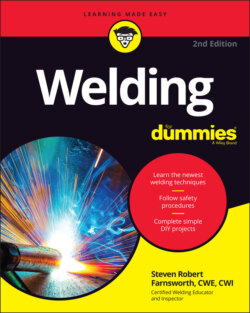Читать книгу Welding For Dummies - Steven Robert Farnsworth - Страница 67
Knowing how to handle injuries
ОглавлениеYou may not be a doctor or an EMT, but if an injury occurs, you can still take some very basic steps to begin treatment and keep the injury from becoming more serious. Below I give you an overview of some of those steps.
Bleeding and wounds: Apply steady pressure with a clean cloth or gloved hand. If the wound isn’t severe, clean it thoroughly and dress it with sterile bandages. If the wound or bleeding is severe, call 911 or go to the hospital immediately.
Broken bones: Don’t move the injured body part or try to reset the bone. If any section of bone is protruding from the skin, cover it with a sterile, moist cloth. Call 911 or go to the hospital immediately.
Electric shock: If you witness someone suffering from an electric shock, don’t touch them! You’ll become part of the circuit and be shocked, too. Instead, quickly turn off the source of the power. If the victim is unconscious, not breathing, or otherwise seriously injured, call 911 immediately.
Gas inhalation: If you or someone in your work area inhales dangerous gases, get them into the fresh air and seek medical assistance immediately.
Poison swallowed: If someone accidentally swallows a poisonous substance from your welding shop, call your poison control center or 911 immediately and follow its instructions. Take care to note the details of the poison that has been consumed. Don’t let the victim drink anything unless you’re directed to do so by emergency personnel or someone from the poison control center.
Heart attack: Welding can be strenuous, and heart attacks while welding aren’t unheard of. If you or someone near you begins to experience severe pain in the chest, pain in the left shoulder, aching in the left arm, shortness of breath, or a bluish color in the lips or fingernails, dial 911 immediately.
Clothing fires: Welding causes a lot of sparks, and those sparks can ignite clothing. If your clothing catches fire, strip it off immediately if possible. If you can’t strip it off quickly, you should stop, drop, and roll to put out the fire. Don’t run around — that fans the flames and makes the fire larger. You can purchase a fire blanket to help extinguish small clothing fires or other fires in your shop. These blankets are usually made of fiberglass or wool treated with a fire retardant chemical, and you can buy them at a welding supply store or online.
Burns (heat): Each one of the three different types of heat burns has its own treatment. (You can see examples of all three kinds of burns in Figure 3-7.)First-degree burns cause the skin to become red and tender but don’t break the surface of the skin. If you suffer a first-degree burn, run cold water over the area to cool it off and then cover it with a clean cloth and apply sterile bandages. Don’t use ice on a burn because it can damage the tissue.Second-degree burns occur when the skin is severely damaged; they commonly involve blisters and even breaks in the skin. If you suffer a second-degree burn, run cold water over it to decrease the pain and then cover the affected area with a sterile bandage. If a blister forms, don’t try to break it.Third-degree burns are the most serious type. If you suffer a third-degree burn, you likely feel very little pain in the affected area because the nerve endings have been destroyed. If you suffer a third-degree burn, seek medical attention immediately. If clothing is embedded in the burn, don’t try to remove it yourself.
Burns (chemical): Some chemicals can cause burns; if your skin comes in contact with one of these materials, immediately flush the area with water. Remove all contaminated clothing and cover the burn with a clean, dry cloth. If the burn is serious, seek medical attention.
Eye injuries: If a foreign object strikes or becomes embedded in your eye, place gauze over the eye immediately and secure it with a bandage. Don’t attempt to remove the object. Go to an eye doctor, call 911, or visit an emergency room as soon as possible. If a chemical comes in contact with your eye, flush out the affected area with warm running water right away and then place gauze over the injured eye and seek medical attention. If you think you may have a flash burn on your eye, see a doctor immediately. You shouldn’t try any home remedies, but you can put a cold, wet washcloth over your closed eye to help ease some of the pain. (Flip to “Shielding yourself from burns” earlier in the chapter for more on flash burns.)
Plume poisoning: If your welding area isn’t well ventilated and you’re not wearing a respirator, you can suffer from plume poisoning, which is sickness or injury that results from inhaling dangerous welding byproducts. If you accidentally inhale those substances, you should immediately get away from the plume and into some fresh air. Then seek medical assistance right away. For more on respirators, check out “Watching health hazards: Using a respirator and Material Safety Data Sheets” earlier in the chapter.
FIGURE 3-7: The three different kinds of heat burns.
